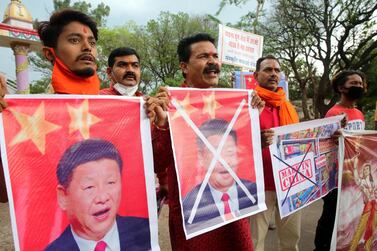On Tuesday, 20 Indian soldiers were killed in a confrontation with Chinese troops along a disputed border high in the Himalayas.
The troops fought each other with fists and rocks, Indian security officials said, and resulted in casualties on both sides.
Chinese officials said that Indian troops had twice crossed the de facto border and launched an attack.
Zhao Lijian, a Chinese foreign ministry spokesman, said that "the Indian side severely violated our consensus and twice crossed the border line and provoked and attacked the Chinese forces."
Tensions have been brewing for weeks in the area. Here's what you need to know.
What is the frontier in dispute?

There are actually two large areas the nations have yet to agree borders for. One is between the Indian Ladakh region and Chinese Xinjiang, where Tuesday's incident occurred. The other is Arunachal Pradesh. There are other smaller disputed areas.
The disputed territory includes popular tourist destination Pangong Tso lake, the highest salt water lake in the world covering an area over 700 square kilometres. The 45 km-long western portion is in Indian control.
When did the dispute begin?
Like many of the world's border conflicts, this has roots in colonialism.
When Britain was the colonial ruler on India in 1914 it held a conference with the Tibetan and Chinese governments to set the border.
But Beijing has never recognised the 1914 boundary, known as the McMahon Line.The border dispute first flared up during a visit by India's first prime minister Jawaharlal Nehru to Beijing in 1959.
Mr Nehru questioned the boundaries shown on official Chinese maps, prompting Chinese Premier Zhou Enlai to reply that his government did not accept the colonial frontier.
Since then, India and China have never formally agreed on how long their frontier is.
India gives a figure of 3,500 kilometres. China does not give a number, but state media says the border should be just 2,000 km when China's claims in Jammu, Kashmir, Ladakh and other regions are taken into account.
China claims about 90,000 square kilometres of territory in India’s northeast, while India says China occupies 38,000 square kilometres of its territory in the Aksai Chin Plateau in the Himalayas, a contiguous part of the Ladakh region.
After a conflict in 1962 (more on that below) the two sides established 3,380-kilometre Line of Actual Control (LAC) as a border mark.
Has there been conflict over the border before?

The countries fought a brief war in 1962 in which China won out, taking a large chunk of territory from India and establishing the LAC.
Further deadly clashes followed in 1967, but the last fatalities along the disputed border were in 1975, when Chinese troops killed four Indian soldiers in an ambush in the Twang region of Arunachal Pradesh state.
In 2017 there was a 72-day showdown after Chinese forces moved into the disputed Doklam plateau on the China-India-Bhutan border. Infrastructure building near or within disputed territories is often blamed for increases in tensions.
After that India's Prime Minister Narendra Modi and Chinese leader Xi Jinping sought to ease tensions at summits.
What's changed?
The unresolved border issue has quietly but continually reared its head over the decades, but it escalated in May this year.
India recently built a strategic road in Ladakh's Galwan Valley connecting the region to an airbase close to China, along the LAC. The road could allow India to move troops and equipment quickly in the event of a conflict.
In response, Chinese soldiers crossed the boundary in Ladakh at three different points, erecting tents, bringing military hardware and ignoring verbal warnings to leave.
That triggered shouting matches, stone-throwing and fistfights, much of it replayed on television news channels and social media.
Is the situation likely to escalate into conflict?

China said on Wednesday that both sides were seeking a peaceful resolution to the dispute.
“Both sides agree to resolve this matter through dialogue and consultation and make efforts to ease the situation and safeguard peace and tranquillity in the border area,” foreign ministry spokesperson Zhao Lijian said at a daily briefing.
It wasn’t immediately clear what form talks would take. Earlier, Indian Defence Ministry spokesperson Col Aman Anand did not respond immediately to queries on the situation or whether talks were planned to defuse the tensions.
The nations are the most populous in the world and are nuclear powers, so if they cannot reach an agreement, the issue could destabilise the region.







